By Scott Irwin and Darrel Good, Department of Agricultural and Consumer Economics, University of Illinois
There continues to be a lot of discussion about the likely magnitude of U.S. corn production in 2016, with much of current focus on planted acreage.
Low commodity prices, along with the 2.8 million acre reduction in winter wheat seedings and the likelihood that there will be fewer prevented plantings in 2016, create uncertainty about the likely magnitude of total acreage of spring planted crops, as well as uncertainty about the acreage of individual crops.
For the most part, current expectations are that total planted acreage may decline from that of 2015, but that corn acreage will increase. The Grains and Oilseeds Outlook at last week's USDA Outlook Forum, for example, projected plantings of the 8 major crops would decline by 5.5 million acres (2.2 percent) in 2016/17, but that corn acreage would increase by two million acres (2.3 percent) to a total of 90 million acres. The USDA will release the results of its March survey of 2016 planting intentions in the Prospective Plantings report to be released on March 31.
In addition to the magnitude of planted acreage, the size of the 2016 corn crop will obviously be determined by the average yield of the crop. Factors determining yield will unfold over the next six months. For the time being, yield expectations are generally based on trend yield analysis. For example, the USDA projected a 2016 U.S. average corn yield of 168 bushels per acre at last week's Outlook Forum, just slightly below the 2015 average of 168.4 bushels.
This raises the perennial issue of what, if anything can be learned from the historical trends and patterns of U.S. average corn yields. In addition, there is the question of whether the trend yield calculation should be altered by information that would influence expectations about weather during the upcoming growing season. This year, for example, there is particular interest in whether the current El Niño episode should influence expectations about 2016 growing season weather and any resulting deviation from trend yield.
Here, we first briefly review the history of corn yield trends and patterns from 1960 through 2015 as a basis for calculating a trend yield for 2016 and potential deviation from trend yield. We then review corn yields in other years of strong El Niño episodes to determine if the expectation of trend yield or potential deviation from trend should be altered due to the current El Niño episode.
Historical Yields and Patterns
We provided a detailed analysis of historical U.S. average corn yields in the farmdoc daily article of February 26, 2015. That analysis is not repeated, but is briefly summarized here as a starting point in forming yield expectations for 2016. We continue to maintain that U.S. average corn yield expectations should be based on the longest sample of data with a stable trend yield component.
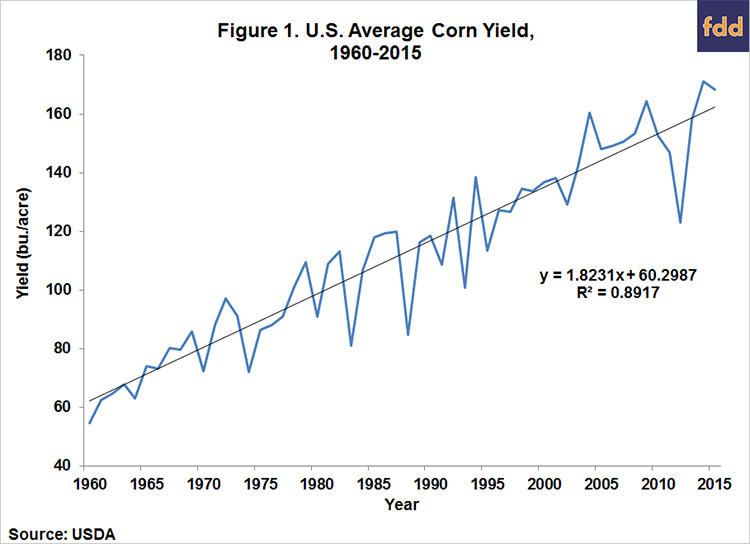
Since we have been unable to find significant evidence of trend yield shifts since 1960 in previous research (e.g., Tannura, Irwin, and Good, 2008a), we argue that the period of 1960-2015 best meets this criterion. As shown in Figure 1, U.S. average corn yields have trended higher since 1960. We found that a linear trend is the best fit to actual average yields over that period, explaining 89.2 percent of the variation in annual average yields.
Yields have increased at a rate of 1.82 bushels per acre per year, but there has been substantial year-to-year variation from trend yield, as shown in Figure 2. Over the 56-year period, the average yield was above the trend yield in 61 percent of the years and below the trend in 39 percent of the years.
Since all deviations from a linear trend must sum to zero, this means that in the 39 percent of years with a below trend yield the deviations were on average larger than the deviations in the more frequent years when yields were above trend. Specifically, the average deviation below trend was 9.5 bushels while the average deviation above trend was 6.1 bushels.
The largest deviation below trend was 33.8 bushels (2012) while the largest deviation above trend was 18 bushels (2004). The deviation below trend yield exceeded 6.0 bushels in 13 years, or 23 percent of the time, and the deviation above trend equaled or exceeded 6.0 bushels in 15 years, or 27 percent of the time.
The frequency and magnitude of deviations are logical for the following reasons: good (normal) growing season weather occurs more frequently than poor weather and good growing season weather helps corn yields less than poor weather hurts yields due to the non-linearity of the relationship between corn yields and precipitation (e.g., Tannura, Irwin, and Good, 2008b; Irwin, Good, and Tannura, 2009).
In addition to showing large positive and negative deviations from trend, the previous analysis (farmdoc daily, February 26, 2015) found that the duration of consecutive years with above- or below-trend yields has varied considerably and the correlation between yield deviations in consecutive years is negligible. This diverse and largely random set of yield patterns suggests that the most objective early-season yield expectation for any year, including 2016, should be based on the trend of actual yields. Figure 1 indicates that the best linear fit of actual yields in the U.S. from 1960 through 2015 results in an "unconditional" trend calculation for 2016 of 164.2 bushels.
This methodology actually results in a slight under-estimate of trend yield due to the asymmetric effect of weather on actual yields (as indicated above) so that the impact of technology (trend) is under-estimated due to sharp reductions in yield from poor weather years, such as 1974, 1983, 1988, 1993, and 2012. Our previous research on crop weather models that adjust for the asymmetric effect of weather on crop yields indicates the downward bias is about one-tenth of a bushel for trend coefficients (Irwin, Good, and Tannura, 2009).
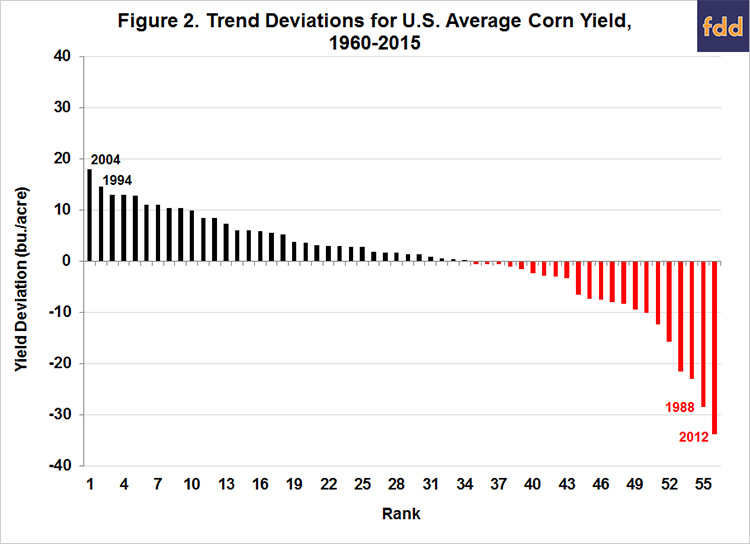
This translates into a downward bias in unconditional trend yield forecasts at the national level of about two bushels per acre. If we add this bias estimate to the unconditional trend yield estimate of 164.2 bushels per acre the result is a corn trend yield projection of 166.2 bushels for 2016. Based on historical yield deviations from the unconditional trend, the probability of yield being below (above) trend in 2016 is 39 (61) percent.
The probability of yields being below (above) the unconditional trend by six bushels or more is about 23 (27) percent. Note that our trend yield estimate of 166.2 bushels is slightly lower than the USDA estimate of 168 bushels released during the Grains and Oilseeds Outlook at last week's USDA Outlook Forum. The USDA uses a different sample period and a crop weather model to generate trend yield estimates for corn, so it is not surprising that differences emerge. The important point is that the difference, 1.8 bushels, is not large.
What About El Niño?
There is considerable discussion about the potential impact of the current El Niño episode on U.S. summer weather and the resulting effect on corn yields. The question is: Should the trend yield expectation, as well as the probabilities of above or below trend yield, be adjusted due to this episode? We start with a brief discussion of what constitutes an El Niño episode and then examine the historical record of corn yields in years with events similar to the current one.
As defined by the National Oceanic and Atmospheric Administration (NOAA), "El Niño and La Niña are opposite phases of a natural climate pattern across the tropical Pacific Ocean that swings back and forth every 3-7 years on average. Together, they are called ENSO, which is short for El Niño-Southern Oscillation. The ENSO pattern in the tropical Pacific can be in one of three states: El Niño, Neutral, or La Niña.
El Niño (the warm phase) and La Niña (the cool phase) lead to significant differences from average ocean temperatures, winds, surface pressure, and rainfall across parts of the tropical Pacific. Neutral indicates that conditions are near their long-term average." The definition encompasses four weather factors (temperature, wind, rainfall and surface pressure) and a rather vague description of the geographical location of these factors. The definitions are further refined here as:
El Niño: A warming of the ocean surface, or above-average sea surface temperatures (SST), in the central and eastern tropical Pacific Ocean. Over Indonesia, rainfall tends to become reduced while rainfall increases over the tropical Pacific Ocean. The low-level surface winds, which normally blow from east to west along the equator ("easterly winds"), instead weaken or, in some cases, start blowing the other direction (from west to east or "westerly winds").
La Niña: A cooling of the ocean surface, or below-average sea surface temperatures (SST), in the central and eastern tropical Pacific Ocean. Over Indonesia, rainfall tends to increase while rainfall decreases over the central tropical Pacific Ocean. The normal easterly winds along the equator become even stronger.
Neutral: Neither El Niño or La Niña. Often tropical Pacific SSTs are generally close to average
These definitions center on sea surface temperatures in the eastern and central Pacific Ocean and are the popular way to describe the ENSO episodes. For our purposes, then, El Niño episodes occur when the Oceanic Niño Index (ONI-three month running mean) in that central and eastern Pacific region (Niño 3.4 region) reaches 0.50C above average.
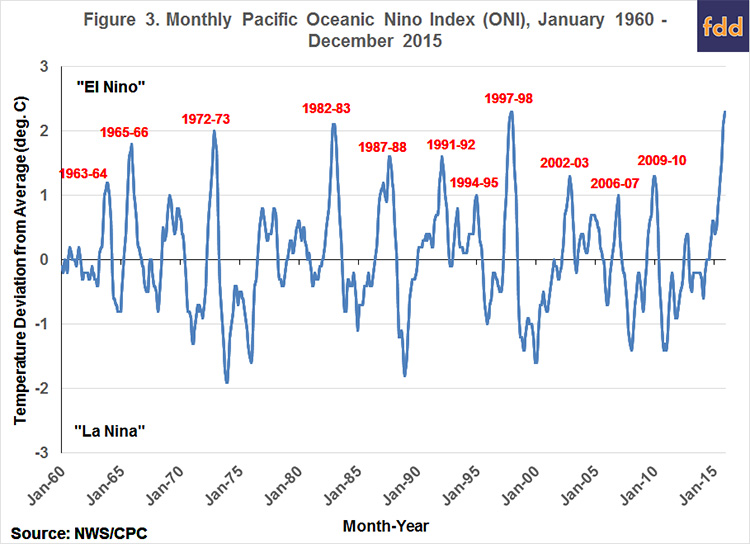
The strength of the El Niño is measured by the magnitude of the deviation in the three-month running mean temperature from the average temperature, where average temperature is based on centered 30-year base periods updated every five years. Figure 3 shows the official ONI data from January 1960 through December 2015. The current El Niño episode is considered one of the strongest episodes since 1960, with the three-month mean temperature exceeding the average temperature by 2.30C in the three months ending January 2016.
Since our interest is in "strong" El Niño episodes that precede the U.S. corn growing season, like the present one, we specifically consider episodes that occur in the portion of the pre-plant period extending from September of the previous calendar year to March of the current year, regardless of how and when the episode eventually transitioned to either neutral or La Niña conditions.
We further define strong El Niño episodes as those in which the peak actual three-month running mean temperature exceeded the long run average temperature by at least 10C. The 11 El Niño episodes that meet these two criteria are labeled in Figure 3.
The three previous episodes that most closely resemble the current episode occurred in 1972-73, 1987-88, and 1997-98. Readers should note that there are other measures of "strong" El Niño episodes that we have not considered, and these other measures may result in a different set of analog years to 2016.
Table 1 presents more detail on the conditions during each of the 11 previous El Niño episodes that meet our definition of strong, and the trend deviation for the average U.S. corn yield in the second year of each pair. Specifically, for each of those episodes, we show the peak temperature anomaly (ranked from lowest to highest), the month of the peak anomaly, the crop year following the peak anomaly, and the yield deviation from trend in those crop years. We also calculate the average yield deviation from trend for all years with a peak anomaly of at least 10C, at least 1.50C, and at least 20C.
The pattern of U.S. average corn yields in years following such strong El Niño episodes paints a mixed picture:
-
The average yield in those years was four to five bushels below trend, depending on how the years are grouped by strength of the El Niño.
-
The deviation from trend ranged from -28.6 bushels to 11 bushels.
- The average yield was below trend 45 percent of the time (five years), compared to the 1960-2015 unconditional average of 39 percent. The yield was more than six bushels below trend 36 percent of the time (four years), compared to the 1960-2015 unconditional average of 23 percent.
-
Of the seven years that the U.S. average yield was at least 10 bushels below trend, 3 followed a strong El Niño.
-
The average yield was equal to or above trend 55 percent of the time (six years), compared to the 1960-2015 unconditional average of 61 percent. The yield was more than six bushels above trend nine percent of the time (one year), compared to the 1960-2015 unconditional average of 25 percent. If the 1972-73 deviation of 5.5 bushels is included, the percentage doubles to 18 percent.
-
Of the nine years since 1960 when the average yield was at least 10 bushels above trend, only one followed a strong El Niño episode.
- In the three years with a peak temperature anomaly of at least 20C, yield exceeded trend in two years by an average of 4.2 bushels, but was below trend by -23 bushels in one year. This suggests, in conditional terms, about a two-thirds chance of a normal crop in 2016 and a one-third chance of a very poor crop. Based on the 2016 trend estimate of 166.2 bushels, yield outcomes would range from 143.2 to 171.7 bushels per acre.
Implications
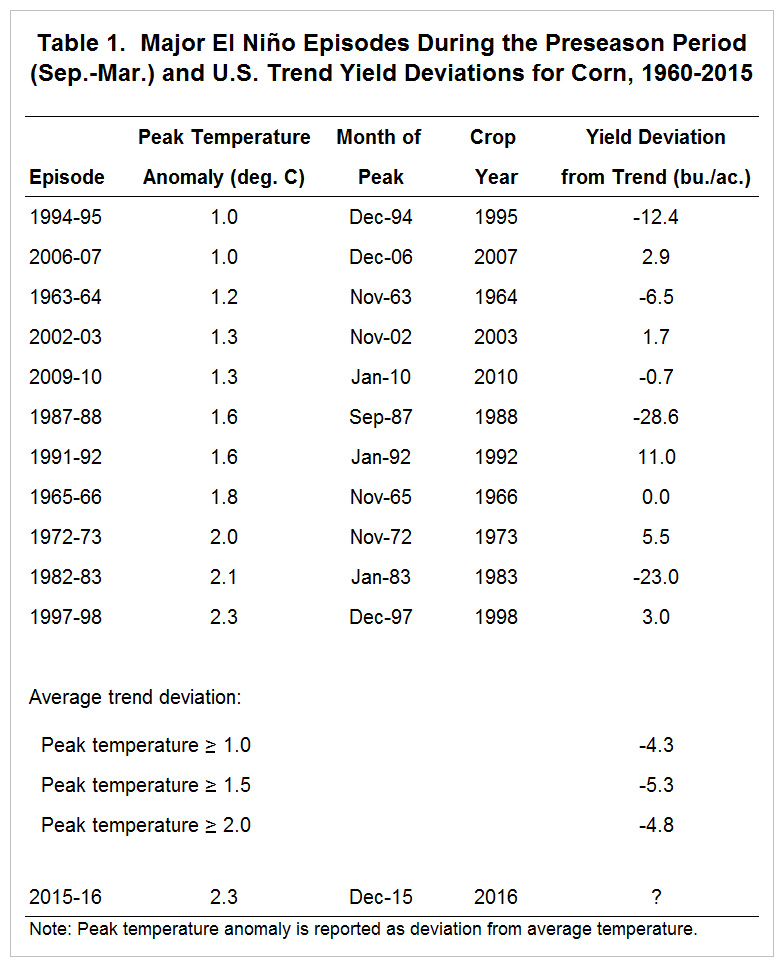
With current U.S. and world corn supplies in some surplus, the size of the 2016 U.S crop will be very important in determining the direction of corn prices over the next year or more. With some increase in corn acreage anticipated, the U.S. average yield will become the focus of the corn market as the planting and growing season progresses.
With planted acreage of 90 million acres, as suggested by USDA analysts, acreage harvested for grain would likely be near 82.5 million acres. An average yield near our calculated trend value of 166.2 bushels per acre would result in a crop near 13.712 billion bushels and likely keep corn supplies in a modest surplus for another year and keep prices near current levels.
We find that the history of corn yields conditioned on a strong El Niño episode, such as the one currently underway, does not provide a definitive indication of the direction or magnitude of the trend deviation to expect in 2016.
However, that history does point to an "elevated" risk of the average yield being below trend when compared to the unconditional risk of a yield below trend.
For example, in the three previous episodes that most closely resemble the current episode, yield exceeded trend in two years by an average of 4.2 bushels, but was below trend by -23 bushels in one year.
Very little yield risk is reflected in the current price structure, and if recent years are a guide, the market will likely continue to take a "wait and see" attitude relative to corn yield expectations.
This attitude becomes all the more interesting given that there is an additional historical tendency for extremely wet conditions in the Midwest during November and December to be followed by a higher than average incidence of corn yields below trend (farmdoc daily, February 15, 2015).
Total November/December precipitation in the Midwest in 2015 was record high. In sum, we believe it is prudent to give serious consideration to managing the elevated risk of below-trend corn yields in 2016, despite the current market structure of prices.

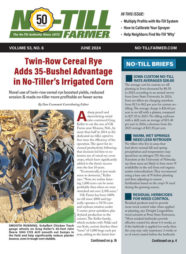




Post a comment
Report Abusive Comment